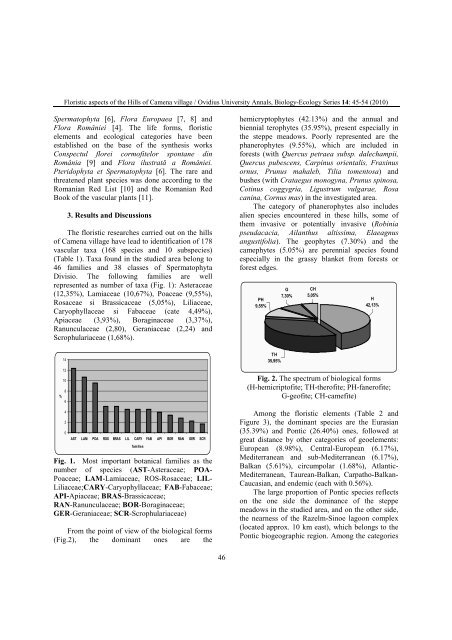VOLUM OMAGIAL - Facultatea de Ştiinţe ale Naturii şi Ştiinţe Agricole
VOLUM OMAGIAL - Facultatea de Ştiinţe ale Naturii şi Ştiinţe Agricole
VOLUM OMAGIAL - Facultatea de Ştiinţe ale Naturii şi Ştiinţe Agricole
Create successful ePaper yourself
Turn your PDF publications into a flip-book with our unique Google optimized e-Paper software.
Floristic aspects of the Hills of Camena village / Ovidius University Annals, Biology-Ecology Series 14: 45-54 (2010)<br />
Spermatophyta [6], Flora Europaea [7, 8] and<br />
Flora României [4]. The life forms, floristic<br />
elements and ecological categories have been<br />
established on the base of the synthesis works<br />
Conspectul florei cormofitelor spontane din<br />
România [9] and Flora ilustrată a României.<br />
Pteridophyta et Spermatophyta [6]. The rare and<br />
threatened plant species was done according to the<br />
Romanian Red List [10] and the Romanian Red<br />
Book of the vascular plants [11].<br />
3. Results and Discussions<br />
The floristic researches carried out on the hills<br />
of Camena village have lead to i<strong>de</strong>ntification of 178<br />
vascular taxa (168 species and 10 subspecies)<br />
(Table 1). Taxa found in the studied area belong to<br />
46 families and 38 classes of Spermatophyta<br />
Divisio. The following families are well<br />
represented as number of taxa (Fig. 1): Asteraceae<br />
(12,35%), Lamiaceae (10,67%), Poaceae (9,55%),<br />
Rosaceae si Brassicaceae (5,05%), Liliaceae,<br />
Caryophyllaceae si Fabaceae (cate 4,49%),<br />
Apiaceae (3,93%), Boraginaceae (3,37%),<br />
Ranunculaceae (2,80), Geraniaceae (2,24) and<br />
Scrophulariaceae (1,68%).<br />
14<br />
12<br />
10<br />
8<br />
%<br />
6<br />
4<br />
2<br />
0<br />
AST LAM POA ROS BRAS LIL CARY<br />
families<br />
FAB API BOR RAN GER SCR<br />
Fig. 1. Most important botanical families as the<br />
number of species (AST-Asteraceae; POA-<br />
Poaceae; LAM-Lamiaceae, ROS-Rosaceae; LIL-<br />
Liliaceae;CARY-Caryophyllaceae; FAB-Fabaceae;<br />
API-Apiaceae; BRAS-Brassicaceae;<br />
RAN-Ranunculaceae; BOR-Boraginaceae;<br />
GER-Geraniaceae; SCR-Scrophulariaceae)<br />
From the point of view of the biological forms<br />
(Fig.2), the dominant ones are the<br />
46<br />
hemicryptophytes (42.13%) and the annual and<br />
biennial terophytes (35.95%), present especially in<br />
the steppe meadows. Poorly represented are the<br />
phanerophytes (9.55%), which are inclu<strong>de</strong>d in<br />
forests (with Quercus petraea subsp. d<strong>ale</strong>champii,<br />
Quercus pubescens, Carpinus orientalis, Fraxinus<br />
ornus, Prunus mah<strong>ale</strong>b, Tilia tomentosa) and<br />
bushes (with Crataegus monogyna, Prunus spinosa,<br />
Cotinus coggygria, Ligustrum vulgarae, Rosa<br />
canina, Cornus mas) in the investigated area.<br />
The category of phanerophytes also inclu<strong>de</strong>s<br />
alien species encountered in these hills, some of<br />
them invasive or potentially invasive (Robinia<br />
pseudacacia, Ailanthus altissima, Elaeagnus<br />
angustifolia). The geophytes (7.30%) and the<br />
camephytes (5.05%) are perennial species found<br />
especially in the grassy blanket from forests or<br />
forest edges.<br />
PH<br />
9,55%<br />
TH<br />
35,95%<br />
G<br />
7,30%<br />
CH<br />
5,05%<br />
H<br />
42,13%<br />
Fig. 2. The spectrum of biological forms<br />
(H-hemicriptofite; TH-therofite; PH-fanerofite;<br />
G-geofite; CH-camefite)<br />
Among the floristic elements (Table 2 and<br />
Figure 3), the dominant species are the Eurasian<br />
(35.39%) and Pontic (26.40%) ones, followed at<br />
great distance by other categories of geoelements:<br />
European (8.98%), Central-European (6.17%),<br />
Mediterranean and sub-Mediterranean (6.17%),<br />
Balkan (5.61%), circumpolar (1.68%), Atlantic-<br />
Mediterranean, Taurean-Balkan, Carpatho-Balkan-<br />
Caucasian, and en<strong>de</strong>mic (each with 0.56%).<br />
The large proportion of Pontic species reflects<br />
on the one si<strong>de</strong> the dominance of the steppe<br />
meadows in the studied area, and on the other si<strong>de</strong>,<br />
the nearness of the Razelm-Sinoe lagoon complex<br />
(located approx. 10 km east), which belongs to the<br />
Pontic biogeographic region. Among the categories





